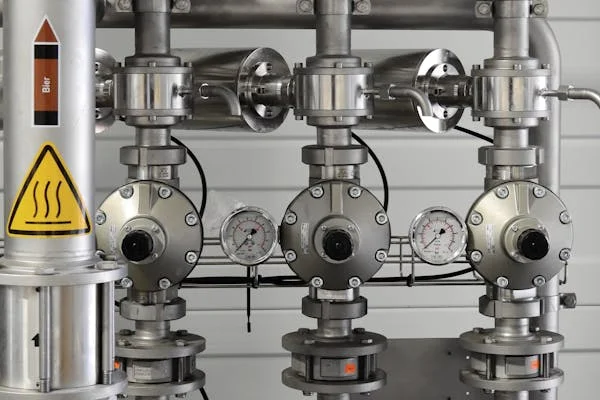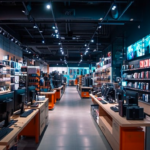Introduction
The DEKRA VT1000 is a cutting-edge explosion-proof inspection camera designed specifically for use in hazardous environments. Whether you’re working in a high-risk industrial setting or performing complex inspections in oil rigs or chemical plants, the VT1000 is built to provide clear, reliable, and safe visual inspection capabilities. With the latest technology, this camera ensures that professionals can conduct thorough inspections without compromising safety.
Key Features of the DEKRA VT1000
The DEKRA VT1000 is packed with advanced features that set it apart from other inspection cameras. Let’s take a deeper dive into each of these features to understand what makes this camera such a valuable tool in hazardous environments.
Explosion Protection
One of the primary selling points of the DEKRA VT1000 is its explosion protection. Certified for ATEX Zone 1 (EX II 2G Ex eb ib pxb IIC T6 Gb) and IECEx, this inspection camera is designed to be used safely in areas where explosive gases, dust, or vapors might be present. This makes it an essential tool for industries where safety is paramount, such as oil and gas exploration, chemical manufacturing, and petrochemical processing.
High-Quality Imaging
The DEKRA VT1000 offers superior imaging capabilities. It is equipped with a Full HD camera that allows for a 30x optical zoom and 12x digital zoom. This feature ensures that even the smallest details are captured clearly, whether you are inspecting equipment, pipes, or tanks. The high-definition imaging capability significantly reduces the chances of missing important visual cues during inspections.
Pan & Tilt Functionality
The VT1000’s camera comes with a pan-and-tilt function, allowing it to rotate 220° and pan infinitely. This feature makes it possible to inspect hard-to-reach areas and get a full 360° view of the environment, offering unparalleled flexibility during inspections. The camera’s mobility ensures that users can inspect a variety of areas without needing to move or reposition the camera manually.
Integrated Lighting
Inspection in dark or poorly lit areas can be challenging, but the DEKRA VT1000 is equipped with four LED spots that help illuminate even the darkest spaces. This built-in lighting feature ensures clear visibility during inspections, making it easier for operators to identify potential issues in environments with low light.
Waterproof Design
With a waterproof design that can withstand depths of up to 6 meters, the DEKRA VT1000 is perfect for underwater inspections or inspections in wet conditions. This feature adds to the camera’s versatility, allowing it to be used in a wide range of challenging environments.
Applications of the DEKRA VT1000
The DEKRA VT1000 is suitable for a wide range of applications across multiple industries. Below are some of the most common ways this versatile camera is used in the field.
1. Tank Inspections
In the oil and gas, petrochemical, and chemical industries, tank inspections are vital for ensuring the integrity of large storage tanks and vessels. The DEKRA VT1000 allows professionals to inspect the interior of tanks without needing to enter the tanks themselves, which can be dangerous. Using its high-definition imaging and flexible pan-and-tilt functionality, workers can easily assess the condition of tanks, identifying signs of corrosion, leaks, or other issues that may require maintenance.
2. Visual Inspections in Hazardous Areas
The explosion-proof design of the DEKRA VT1000 makes it ideal for use in hazardous areas where flammable gases and materials are present. It can be safely used in environments such as refineries, chemical plants, and offshore oil rigs, where the risk of explosions is ever-present. The camera provides a reliable solution for conducting inspections in such high-risk environments without endangering the safety of personnel.
3. Industrial Applications
Beyond hazardous zones, the DEKRA VT1000 also excels in a wide variety of industrial settings. From inspecting power plants and factories to checking the condition of pipelines and machinery, this camera is a versatile tool that enhances the efficiency of industrial inspections. It can be used for regular maintenance checks or emergency inspections when an issue arises.
Benefits of Using the DEKRA VT1000
The DEKRA VT1000 offers several advantages for professionals in industries that require hazardous area inspections. Let’s look at some of the key benefits:
1. Improved Safety
The DEKRA VT1000 helps to enhance safety by allowing operators to conduct remote inspections without needing to enter dangerous areas. This reduces the risk of injury or exposure to hazardous substances. Additionally, its explosion-proof design ensures that it can be safely used in volatile environments.
2. Cost-Effective Inspections
By reducing the need for personnel to enter dangerous or confined spaces, the DEKRA VT1000 helps save costs associated with manual inspections and confined space entry procedures. Additionally, the camera’s high-quality imaging means fewer repeat inspections are needed, further reducing operational costs.
3. Enhanced Operational Efficiency
With features like pan-and-tilt functionality, integrated lighting, and high-definition imaging, the DEKRA VT1000 enhances the efficiency of inspections. It enables quicker, more accurate assessments, ensuring that issues are identified and addressed in a timely manner.
How to Operate the DEKRA VT1000
Using the DEKRA VT1000 is straightforward, even in challenging environments. Here’s a step-by-step guide to help you get started with the camera.
Basic Setup
Before using it, ensure that all the necessary safety precautions are in place. Perform a quick inspection of the camera and ensure that all parts are functioning correctly. Once the setup is complete, power on the camera and ensure that it is connected to the control system.
Camera Controls
It comes with easy-to-use controls that allow operators to zoom in on specific areas, adjust the camera angle, and control the lighting. Use the joystick for pan-and-tilt adjustments and the buttons to zoom in or out.
Inspection Techniques
When conducting an inspection, focus on specific areas of concern, such as equipment joints, seams, and high-traffic areas that may experience wear and tear. Take advantage of the high zoom capabilities to closely examine hard-to-reach spots.
DEKRA VT1000 in Action: Real-World Use Cases
Case Study 1: Oil and Gas Industry
In the oil and gas industry, it is frequently used for tank and pipeline inspections. Operators use the camera to inspect the internal and external conditions of oil tanks and gas pipelines, identifying any signs of wear, corrosion, or leaks. By conducting visual inspections from a safe distance, the camera helps avoid hazardous exposure to toxic chemicals and explosive substances.
Case Study 2: Chemical Manufacturing
Chemical manufacturers rely on it to perform inspections in environments where chemicals and gases pose a significant risk. The camera’s explosion-proof design makes it suitable for use in areas where flammable chemicals are stored or processed, ensuring that inspections can be carried out without the risk of ignition.
Why Choose the DEKRA VT1000 Over Other Inspection Cameras?
The DEKRA VT1000 stands out due to its robust features and certification for hazardous environments. Compared to other inspection cameras, the VT1000 offers superior imaging quality, enhanced mobility with pan-and-tilt functionality, and an explosion-proof design that ensures safety in volatile areas. It also provides long-lasting durability, making it a more reliable option for industries that require frequent inspections.
Maintenance and Care for the DEKRA VT1000
To ensure the longevity of it, regular maintenance is essential. Here are some tips for taking care of the camera:
- Regularly inspect the camera lens for dirt or damage. Clean the lens with a soft cloth to maintain clear visibility.
- Check the camera’s seals and gaskets. Ensure that they are intact to maintain the camera’s waterproof functionality.
- Store the camera properly. When not in use, store the DEKRA VT1000 in a safe, dry place to protect it from dust and moisture.
Conclusion
It is an essential tool for industries where safety and accuracy are critical. Its explosion-proof design, high-quality imaging, and advanced features make it a standout choice for professionals in hazardous environments. Whether you are conducting tank inspections, performing visual inspections in hazardous areas, or working in industrial applications, the DEKRA VT1000 offers a reliable and efficient solution that enhances safety, reduces costs, and improves operational efficiency. By following proper maintenance guidelines, you can ensure that your DEKRA VT1000 remains in optimal condition, ready for use in demanding environments.
FAQs about the DEKRA VT1000
Which industries use the DEKRA VT1000?
It is used in oil and gas, chemical manufacturing, petrochemical, and other hazardous industries requiring safe inspections.
How is the DEKRA VT1000 safe in hazardous environments?
It is ATEX and IECEx certified, ensuring explosion-proof safety in volatile areas with flammable gases or dust.
What is the zoom range of the DEKRA VT1000?
It has a 30x optical zoom and 12x digital zoom for detailed inspections.
Can the DEKRA VT1000 be used underwater?
Yes, it is waterproof up to 6 meters, making it suitable for underwater inspections.
How does the pan-and-tilt functionality work?
The camera rotates 220° and pans infinitely, offering full 360° inspection capability.
What are the main benefits of the DEKRA VT1000?
The camera enhances safety, reduces costs, and improves operational efficiency for inspections in hazardous environments.







